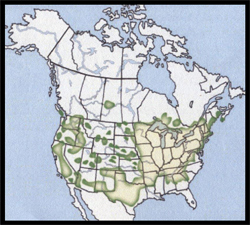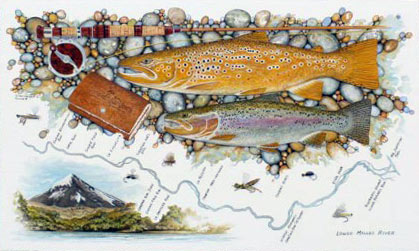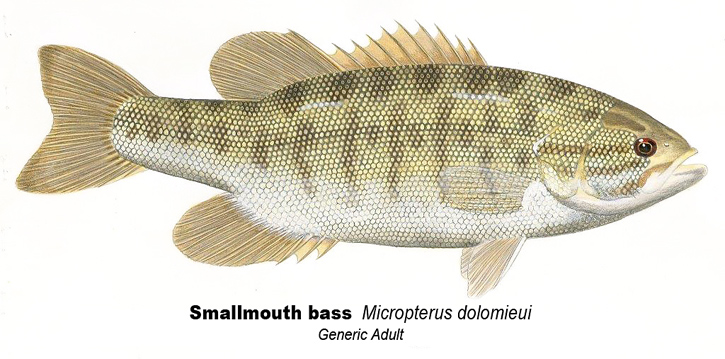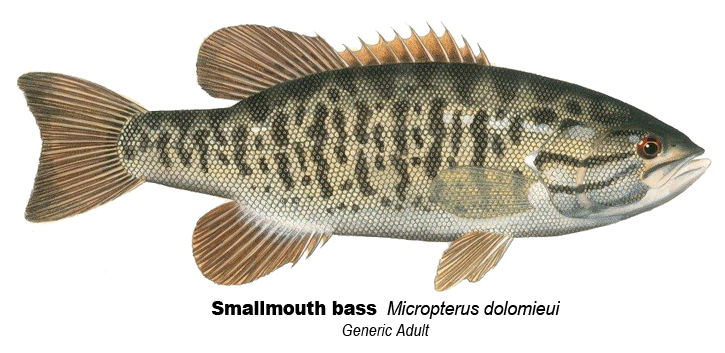Smallmouth Bass, April 2015, Fish of the Month!
Well folks, those of you who prefer quarry larger than our American small Sunfishes will be happy to know that, with these entries, we leave the little guys behind and move into the realm of fish that are not typically thought of as being members of the Sunfish family. We're now in the realm of the North American basses (the genus Micropterus).
Smallmouth Bass
Micropterus dolomieui
Local Names:
Bronzeback, Smallmouth black bass, Green bass, Brown bass, Redeye, Smallie, Swago bass, Trout-bass
Average Size:
10 to 18 inches
1 to 3 pounds
Distinguishing Field Marks:
(See the illustration.)
-
There are 2 dorsal fins which are joined. The first has 10 stiff spines with the last of these appearing as part of the second dorsal fin.
-
There is no obvious separation between the two dorsal fins.
-
The caudal fin is slightly concave along its trailing edge.
The anal fin has 3 spines of graduated length on its leading edge.
The head is of moderate size.
The eye is red.
The mouth is of moderate size with its upper jaw extending backward to the rear margin of the eye.
Depending on the surrounding habitat colors, Smallmouth bass exhibit a wide range of body colorings.
North American Range:
Map to the right shows approximate range in North America.
Diet:
Young Smallmouth bass feed on plankton, then graduate to aquatic insects and other invertebrates, then to mainly crayfish and fish. However, Smallmouths are omnivorous opportunists that will take whatever comes their way and as their moods change. They are also noted for feeding at the water's surface, at mid-levels and on the bottom.
Biology:
Smallmouth bass spawns from late spring into early summer, usually in May and June. Spawning begins as males select nest sites, in 2 to 20 feet (60.96 to 609.60 cm.) of water, usually near large rocks or boulders on a gravel, rock, or sand bottom, and only rarely near vegetation. These nest sites are widely spaced and certain of them may be used by the same male for several consecutive seasons. The nests are often very large, sometimes as much as 4 to 6 feet in diameter. When the nests are ready, a female will join a mate and the spawning will begin. The ritual is much less showy than in the small colonial nesting sunfishes of the genus Lepomis. The pairs hover over the nest and rub and nuzzle against one another and then the female turns onto one side while the male remains upright and eggs are released and fertilized. These small spawnings are interspersed with the pair hovering very close to one another and circling over the nest and then commencing another short spawning interval, this takes place over a period of several hours until the female moves off to frequently mate with another male. The fertilized eggs are adhesive and sink to the bottom of the nest where they anchor through their incubation, usually a period of from 4 to 10 days. During this period, the male stays at the nest, fanning the eggs to provide them adequate oxygen. When they have hatched, the new-born young lie dormant in the nest gravel for an additional 5 to 7 days as they absorb their yolk sacs. The male parent continues his vigil until the majority of the young have left the nest. Throughout this period, the male Smallmouth is very aggressive toward any intrusions into the nest space, and for this reason these often large individuals are rather easy to aggravate into striking the angler's offering, especially if it actually crosses the guarded nest. Anglers enjoying this sport must bear in mind that removing the male parent from the nest can result in the loss of all the eggs and young as they die of asphyxiation, or become prey.
Adult male Smallmouth bass typically are sexually mature in their 3rd to 5th years, females in their 4th to 6th years. Many factors contribute to the fact that consecutive year classes may vary widely in numbers, as spawning success is uncertain at best.
Both juvenal and adult Smallmouth bass are very intolerant of sudden changes in water temperature, either upward or down. Many local fish kills of this species are the result of a strong summer cold front pushing much colder deep lake water into the shallows inhabited by Smallmouths.
Fly Fishing for Redeye Bass:
Lakes, large and small, rivers, the lower portions of streams, any clear to slightly turbid water may hold these fish, although their preference is definitely for water of high quality. They are most often associated with rocky bottoms and are not usually found close to vegetation.
Although they can be taken throughout the open water months, Smallmouths come most willingly at the cooler ends of the season, spring and fall. At these times this species will aggressively attack poppers and bugs fished on the water's surface. The strong takes, powerful runs, and somersaulting jumps of even a small Smallmouth bass make for a very exciting and satisfying fishing experience. When selecting terminal tackle for Smallmouth fishing, keep in mind that this is a Smallmouth and will frequently refuse large offerings. In warmer weather, rivers with moderate flows will still produce good Smallmouth fishing.
Equipment should be selected to most comfortably present the chosen type of fly. Normally that will range from 6 to 8 weight fly fishing outfits.
Significance to Humans:
For centuries the Smallmouth bass has been of considerable importance as both a food and game fish. As late as the early 1900s Smallmouth bass were commercially harvested by hook and line and nets and were marketed at very low prices. By the 1930s a significant decline in numbers of the species was noted and efforts were undertaken to designate the Smallmouth as a game species only, this was successful and commercial fishing for this species is no longer legal.
Although the Largemouth bass is America's most popular game fish, the Smallmouth maintains a dedicated following of anglers who rank it as America's most exciting game fish species; and, pound-for-pound, that accolade is hard to argue.
Young Smallmouth bass can thrive very well on live foods in a large well-oxygenated home aquarium.
Status:
Cyclically thriving and generally maintaining.








